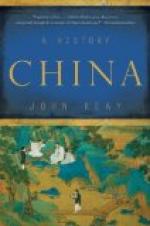p. 11: This is a summary of my own theories. Concerning the Tungus tribes, K. Jettmar (Wiener Beitraege zur Kulturgeschichte, vol. 9, 1952, p. 484f and later studies) has proposed a more refined theory; other parts of the theory, as far as it is concerned with conditions in Central Asia, have been modified by F. Kussmaul (in: Tribus, vol. 1952-3, pp. 305-60). Archaeological data from Central Asia have been analysed again by K. Jettmar (in: The Museum of Far Eastern Antiquities, Bulletin No. 23, 1951). The discussion on domestication of large animals relies on the studies by C.O. Sauer, H. von Wissmann, Menghin, Amschler, Flohr and, most recently, F. Han[vc]ar (in: Saeculum, vol. 10, 1959, pp. 21-37 with further literature), and also on my own research.
p. 12: An analysis of the situation in the South according to Western and Chinese studies is found in H.J. Wiens, China’s March toward the Tropics, Hamden 1954. Much further work is now published by Ling Shun-sheng, Rui Yi-fu and other anthropologists in Taipei. The best analysis of denshiring in the Far East is still the book by K.J. Pelzer, Population and Land Utilization, New York 1941. The anthropological theories on this page are my own, influenced by ideas of R. Heine-Geldern and Gordon Luce.
p. 14: Sociological theory, as developed by R. Thurnwald and others, has been used as a theoretical tool here, together with observations by A. Credner and H. Bernatzik. Concerning rice in Yang-shao see R. Heine-Geldern in Anthropos, vol. 27, p. 595.
p. 15: Wu Chin-ting defended the local origin of Yang-shao; T.J. Arne, J.G. Andersson and many others suggested Western influences. Most recently R. Heine-Geldern elaborated this theory. The allusion to Indo-Europeans refers to the studies by G. Haloun and others concerning the Ta-Hsia, the later Yueeh-chih, and the Tocharian problem.
p. 16: R. Heine-Geldern proposed a “Pontic migration”. Yin Huan-chang discussed most recently Lung-shan culture and the mound-dwellers.
p. 17: The original Chu-shu chi-nien version of the stories about Yao has been accepted here, together with my own research and the studies by B. Karlgren, M. Loehr, G. Haloun, E.H. Minns and others concerning the origin and early distribution of bronze and the animal style. Smith families or tribes are well known from Central Asia, but also from India and Africa (see W. Ruben, Eisenschmiede und Daemonen in Indien, Leiden 1939, for general discussion).—For a discussion of the Hsia see E. Erkes.
Chapter Two
p. 19: The discussion in this chapter relies mainly upon the Anyang excavation reports and the studies by Tung Tso-pin and, most strongly, Ch’en Meng-chia. In English, the best work is still H.G. Creel, The Birth of China, London 1936 and his more specialized Studies in Early Chinese Culture, Baltimore 1937.




